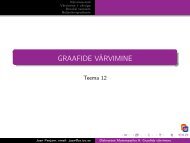Reactive Systems: Modelling, Specification and Verification - Cs.ioc.ee
Reactive Systems: Modelling, Specification and Verification - Cs.ioc.ee
Reactive Systems: Modelling, Specification and Verification - Cs.ioc.ee
You also want an ePaper? Increase the reach of your titles
YUMPU automatically turns print PDFs into web optimized ePapers that Google loves.
12 CHAPTER 2. THE LANGUAGE CCS<br />
Exercise 2.1 Give a CCS process that describes a clock that ticks at least once,<br />
<strong>and</strong> that may stop ticking after each clock tick. <br />
Exercise 2.2 Give a CCS process that describes a coff<strong>ee</strong> machine that may behave<br />
like that given by (2.1), but may also steal the money it receives <strong>and</strong> fail at any<br />
time. <br />
Exercise 2.3 A finite process graph T is a quadruple (Q, A, δ, q0), where<br />
• Q is a finite set of states,<br />
• A is a finite set of labels,<br />
• q0 ∈ Q is the start state <strong>and</strong><br />
• δ : Q × A → 2 Q is the transition function.<br />
Using the operators introduced so far, give a CCS process that ‘describes T ’. <br />
Parallel composition It is well-known that a computer scientist working in a<br />
research university is a machine for turning coff<strong>ee</strong> into publications. The behaviour<br />
of such an academic may be described by the CCS process<br />
CS def<br />
= pub.coin.coff<strong>ee</strong>.CS . (2.3)<br />
As made explicit by the above description, a computer scientist is initially k<strong>ee</strong>n<br />
to produce a publication—possibly straight out of her doctoral dissertation—, but<br />
she n<strong>ee</strong>ds coff<strong>ee</strong> to produce her next publication. Coff<strong>ee</strong> is only available through<br />
interaction with the departmental coff<strong>ee</strong> machine CM. In order to describe systems<br />
consisting of two or more processes running in parallel, <strong>and</strong> possibly interacting<br />
with each other, CCS offers the parallel composition operation, which is written<br />
‘|’. For example, the CCS expression CM | CS describes a system consisting of<br />
two processes—the coff<strong>ee</strong> machine CM <strong>and</strong> the computer scientist CS—that run<br />
in parallel one with the other. These two processes may communicate via the communication<br />
ports they share <strong>and</strong> use in complementary fashion, namely coff<strong>ee</strong> <strong>and</strong><br />
coin. By complementary, we mean that one of the processes uses the port for input<br />
<strong>and</strong> the other for output. Potential communications are represented in Figure 2.2<br />
by the solid lines linking complementary ports. The port pub is instead used by<br />
the computer scientist to communicate with her research environment, or, more<br />
prosaically, with other processes that may be present in her environment <strong>and</strong> that<br />
are willing to accept input along that port. One important thing to note is that the<br />
link betw<strong>ee</strong>n complementary ports in Figure 2.2 denotes that it is possible for the
















